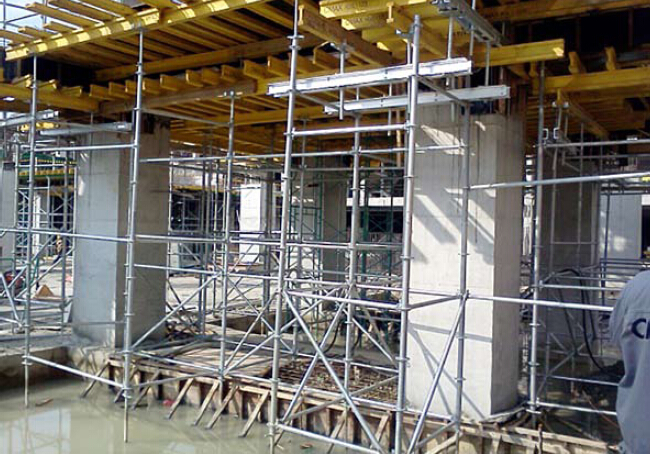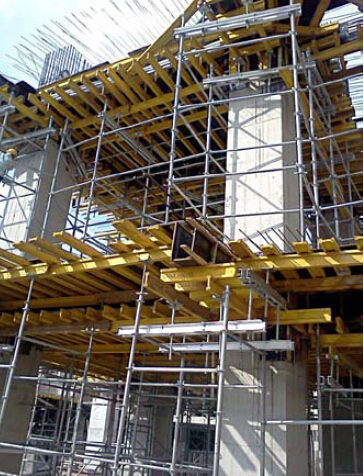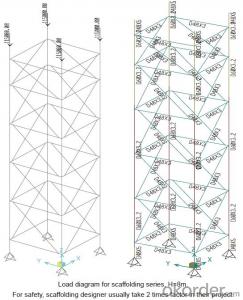RingLock Scaffolding Accessories for Formwork and Scaffolding System
- Loading Port:
- Tianjin
- Payment Terms:
- TT OR LC
- Min Order Qty:
- 50 m²
- Supply Capability:
- 1000 m²/month
OKorder Service Pledge
Quality Product, Order Online Tracking, Timely Delivery
OKorder Financial Service
Credit Rating, Credit Services, Credit Purchasing
You Might Also Like
Ring-lock Scaffolding
A support system for construction, ownsadvantages of both cup-lock scaffolding andshoring tower.
It is in the development direction of new typescaffolding.
It is widely used in buildings, bridges, tunnels etc..
Characteristics:
◆ Easy to storage and transportation
◆ High degree of standardization
◆ Easy and quick erection
◆ Excellent stability and bearing capacity


- Q:How are steel formwork panels connected together?
- To create a sturdy and stable structure for pouring concrete, steel formwork panels are joined together using various methods. One commonly employed technique involves the use of steel pins or bolts, which are inserted into pre-drilled holes in the panels. These pins or bolts are then tightened or secured with nuts, ensuring a firm connection between the panels. Another approach involves the utilization of clamps or couplers, which are positioned along the edges of the panels and tightened to hold them in place. These clamps or couplers can be easily adjusted or removed, allowing for flexibility in the formwork system. Furthermore, certain steel formwork panels possess interlocking mechanisms like slots or hooks, which enable effortless alignment and connection. These interlocking features facilitate a seamless connection between the panels, resulting in a smooth and uninterrupted surface for pouring concrete. In conclusion, the connection of steel formwork panels is vital for preserving the integrity and stability of the formwork system during the concrete pouring process. The chosen method of connection depends on the specific design and requirements of the project, as well as the type of steel formwork being utilized.
- Q:Can steel formwork be used for both above-ground and below-ground structures?
- Yes, steel formwork can be used for both above-ground and below-ground structures. Steel formwork is known for its strength, durability, and versatility, making it suitable for various construction projects. Above-ground structures, such as buildings and bridges, often require formwork to shape and support the concrete during the casting process. Steel formwork provides the necessary strength and stability to withstand the weight and pressure of the concrete. Similarly, below-ground structures like basements, tunnels, and foundations can also benefit from steel formwork. These structures often require formwork to create the desired shape and provide support during the concrete pouring and curing phases. Steel formwork can withstand the pressure exerted by the surrounding soil and groundwater, ensuring the integrity of the structure. Moreover, steel formwork offers advantages such as reusability, easy assembly and disassembly, and the ability to withstand harsh environmental conditions. These characteristics make it an ideal choice for both above-ground and below-ground construction projects, where durability and efficiency are crucial. However, it is important to consider the specific requirements of each project and consult with structural engineers and construction experts to ensure the appropriate formwork system is selected.
- Q:What are the different edge protection systems available for steel formwork?
- There are several different edge protection systems available for steel formwork, each designed to provide safety and support for construction workers. One common edge protection system is the use of guardrails. These guardrails are typically made of steel or aluminum and are installed along the edges of the formwork to prevent workers from falling off. They are often adjustable in height and can be easily installed and removed as needed. Another type of edge protection system is the use of safety nets. These nets are installed below the formwork and act as a safety barrier to catch any workers or materials that may fall. Safety nets are typically made of high-strength synthetic fibers and are designed to absorb the impact of a fall, reducing the risk of injury. Some edge protection systems also include toe boards. Toe boards are installed along the bottom edge of the formwork to prevent tools, equipment, or materials from falling off and potentially causing injury. They are typically made of wood or metal and are securely attached to the formwork. In addition to these systems, there are also edge protection solutions that incorporate a combination of guardrails, safety nets, and toe boards. These comprehensive systems provide multiple layers of protection to ensure the safety of workers on the construction site. Overall, the different edge protection systems available for steel formwork are designed to prevent falls, protect workers, and ensure a safe working environment. It is important for construction companies and workers to carefully assess the specific requirements of their project and select the appropriate edge protection system to meet their needs.
- Q:How does steel formwork affect the overall construction site noise pollution?
- The overall construction site noise pollution can be significantly reduced by steel formwork. Steel formwork offers better acoustic insulation properties compared to traditional wooden formwork. The sound waves are absorbed and dampened by the rigid and dense nature of steel materials, resulting in minimized noise propagation. This is particularly advantageous in densely populated areas or construction sites near residential or commercial areas. In addition, steel formwork is commonly prefabricated, meaning it is manufactured off-site and then assembled on-site. This process reduces construction noise by requiring fewer on-site activities and decreasing the need for cutting, drilling, and hammering, which are major sources of noise pollution. Moreover, the use of steel formwork can lead to faster construction times, resulting in shorter exposure to noise for neighboring communities. Furthermore, steel formwork is more durable and long-lasting than wooden formwork, allowing it to be reused multiple times. This reusability reduces the frequency of formwork installation and dismantling, further decreasing noise pollution generated during the construction process. Overall, the utilization of steel formwork in construction can greatly contribute to the minimization of noise pollution at the construction site. The superior acoustic insulation properties, reduced on-site activities, and longer lifespan all collaborate to create a quieter and more environmentally friendly construction environment.
- Q:Can steel formwork be used in cold weather conditions?
- Certainly! Steel formwork is applicable even in cold weather conditions. Steel, being a robust and enduring material, possesses the capability to withstand extreme temperatures. Nevertheless, it is imperative to consider the potential impact of cold weather on both the construction process and the formwork's performance. The major concern during cold weather is the potential influence of freezing temperatures on the concrete's setting and curing processes. Consequently, this can lead to construction delays and a compromise in concrete quality. To address this issue, several measures can be implemented when employing steel formwork in cold weather conditions. To begin with, it is of utmost importance to ensure that the formwork is adequately insulated to prevent heat loss and maintain the necessary temperature for the concrete. This can be accomplished by incorporating insulating materials like polystyrene or foam boards around the formwork. Furthermore, heating devices such as electric blankets or heat lamps can be utilized to sustain the desired temperature during the curing process. These devices should be strategically positioned to uniformly distribute heat without causing damage to the steel formwork. Additionally, meticulous planning of the construction schedule is crucial. This includes taking into consideration the weather forecast and avoiding concrete pouring during periods of extremely low temperatures. Techniques such as utilizing accelerators or special admixtures for cold weather concreting can also be employed to expedite the concrete's setting rate and prevent freezing. In conclusion, while steel formwork can be employed in cold weather conditions, it is essential to implement appropriate precautions to ensure the successful completion of the construction project. Adequate insulation, the utilization of heating devices, and meticulous scheduling are indispensable in mitigating the potential challenges posed by cold weather on the formwork's performance and the concrete's quality.
- Q:Can steel formwork be used for staircase construction?
- Yes, steel formwork can be used for staircase construction. Steel formwork is a versatile and durable material that is commonly used in construction projects, including staircase construction. It provides a strong and stable structure for pouring concrete and ensures precise and accurate shaping of the staircase. Additionally, steel formwork is reusable, making it a cost-effective choice for repetitive construction processes like staircase construction. It also offers flexibility in design, allowing for the creation of various staircase shapes and sizes. Overall, steel formwork is a suitable choice for staircase construction due to its strength, durability, reusability, and design flexibility.
- Q:How does steel formwork handle different concrete curing time requirements?
- Steel formwork is a versatile and durable option for construction projects, including concrete structures. When it comes to handling different concrete curing time requirements, steel formwork offers several advantages. Firstly, steel formwork provides a robust and stable framework for the concrete to be poured into. This ensures that the concrete is held in place and maintains its desired shape during the curing process. Regardless of the required curing time, steel formwork can effectively support the weight and pressure exerted by the concrete, preventing any deformation or collapse. Moreover, steel formwork is highly adjustable and customizable. It can be easily modified to accommodate different curing time requirements. For instance, if a particular section of concrete requires a longer curing time, additional support can be added to the steel formwork to provide extra strength and stability. On the other hand, if a section requires a shorter curing time, the steel formwork can be adjusted accordingly to facilitate quicker curing. Additionally, steel formwork has excellent heat conductivity properties. This allows for efficient heat dissipation during the concrete curing process. Different concrete mixes may have varying heat generation rates during hydration, and steel formwork aids in maintaining uniform curing temperatures. This is particularly beneficial when dealing with concrete structures that have specific curing temperature requirements. Furthermore, steel formwork is reusable and can withstand multiple casting cycles. This means that it can be used for different projects with varying concrete curing time requirements, making it a cost-effective option. The durability and strength of steel formwork ensure its longevity, enabling contractors to adapt to different curing time requirements without the need for constant replacement. In conclusion, steel formwork is well-suited to handle different concrete curing time requirements. Its stability, adjustability, heat conductivity, and reusability make it an ideal choice for construction projects of various scales and complexities. Whether the concrete requires a longer or shorter curing time, steel formwork provides the necessary support and flexibility to ensure successful curing and the creation of strong and durable concrete structures.
- Q:Can steel formwork be used for concrete structures in marine environments?
- Special considerations and precautions are necessary when using steel formwork for concrete structures in marine environments. The high levels of saltwater exposure and corrosive elements in marine environments present unique challenges for steel formwork. The steel formwork can rapidly deteriorate and rust due to the corrosive nature of seawater, which compromises its structural integrity. To mitigate these risks, it is crucial to utilize high-quality corrosion-resistant steel, such as stainless steel or galvanized steel, for the formwork. These materials have superior resistance to corrosion and can withstand the harsh marine environment for an extended period. Furthermore, proper maintenance and regular inspection are essential to promptly identify any signs of corrosion or damage and address them. This maintenance may involve regular cleaning of the formwork to remove accumulated salt or debris and applying protective coatings to prevent corrosion. Additionally, it is vital to consider the design of the formwork to ensure effective drainage and minimize water exposure. Adequate provision should be made for drainage channels and weep holes to prevent water accumulation, which can accelerate corrosion. In conclusion, successful use of steel formwork in marine environments requires careful selection of corrosion-resistant materials, regular maintenance, and proper design considerations. It is advisable to consult experienced professionals and engineers with expertise in marine construction to ensure the durability and longevity of concrete structures in such environments.
- Q:How does steel formwork compare to timber formwork in terms of durability?
- Steel formwork is generally more durable than timber formwork. Steel is a strong and rigid material that can withstand greater loads and pressures compared to timber. It is resistant to warping, rotting, and pest infestations that are common with timber. Additionally, steel formwork has a longer lifespan and requires less maintenance, making it a more durable choice for construction projects.
- Q:Are there any safety concerns associated with steel formwork?
- Yes, there can be safety concerns associated with steel formwork. Some potential issues include the weight and stability of the steel panels, which may require proper bracing and support systems to prevent collapse. Additionally, the sharp edges and corners of steel formwork can pose a risk of injury if not handled carefully. Adequate training, supervision, and adherence to safety protocols are essential to mitigate these concerns.
1. Manufacturer Overview |
|
|---|---|
| Location | |
| Year Established | |
| Annual Output Value | |
| Main Markets | |
| Company Certifications | |
2. Manufacturer Certificates |
|
|---|---|
| a) Certification Name | |
| Range | |
| Reference | |
| Validity Period | |
3. Manufacturer Capability |
|
|---|---|
| a)Trade Capacity | |
| Nearest Port | |
| Export Percentage | |
| No.of Employees in Trade Department | |
| Language Spoken: | |
| b)Factory Information | |
| Factory Size: | |
| No. of Production Lines | |
| Contract Manufacturing | |
| Product Price Range | |
Send your message to us
RingLock Scaffolding Accessories for Formwork and Scaffolding System
- Loading Port:
- Tianjin
- Payment Terms:
- TT OR LC
- Min Order Qty:
- 50 m²
- Supply Capability:
- 1000 m²/month
OKorder Service Pledge
Quality Product, Order Online Tracking, Timely Delivery
OKorder Financial Service
Credit Rating, Credit Services, Credit Purchasing
Similar products
New products
Hot products
Related keywords























